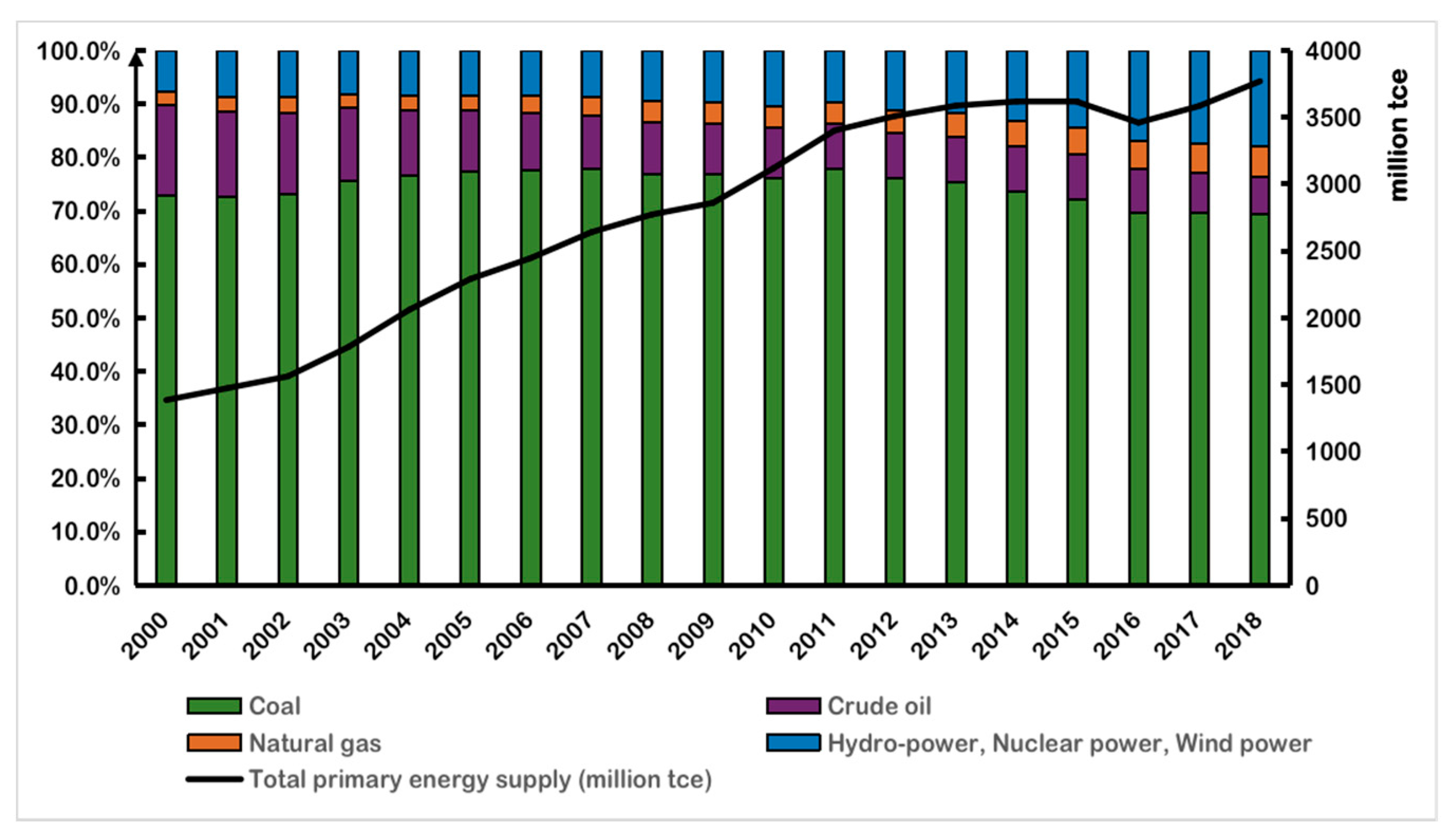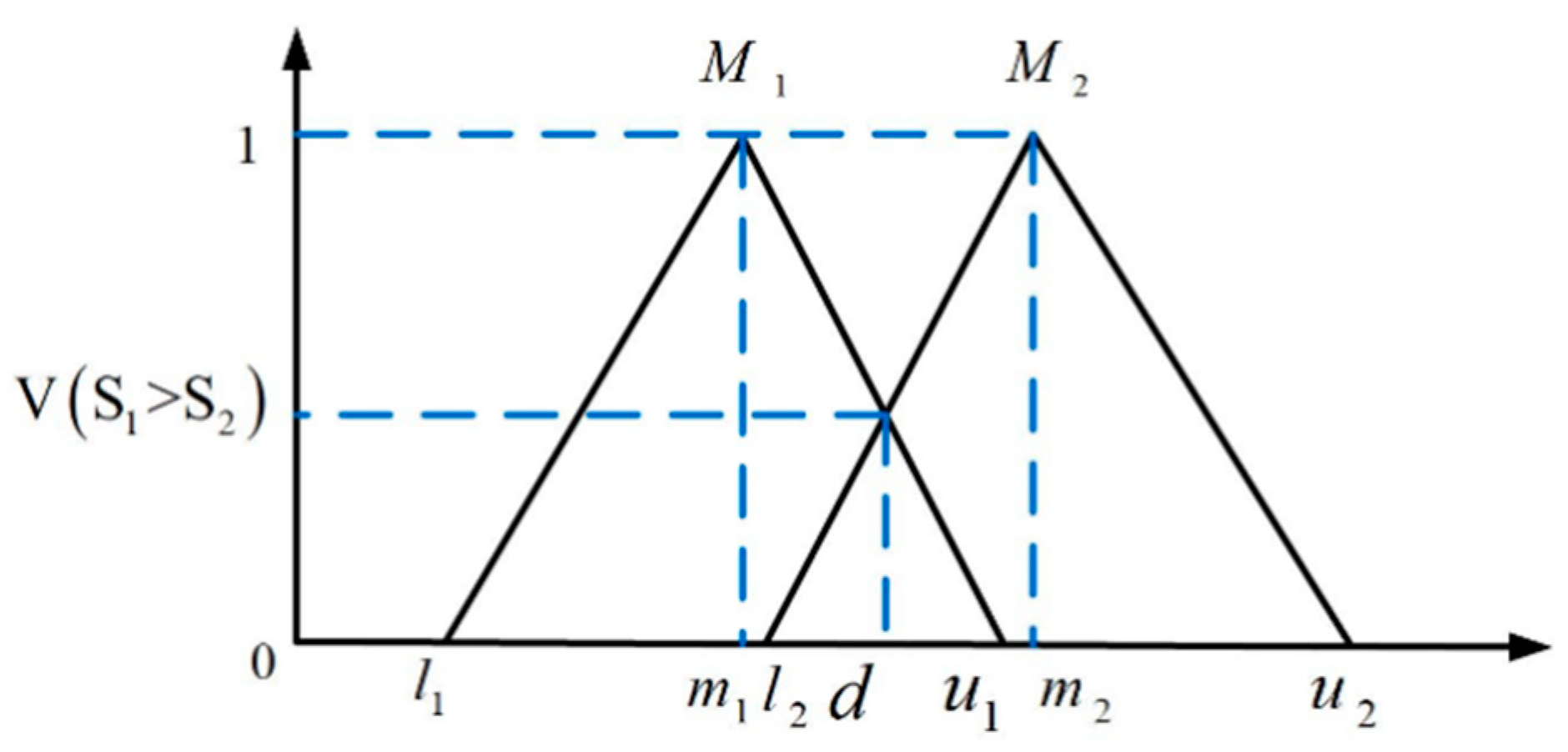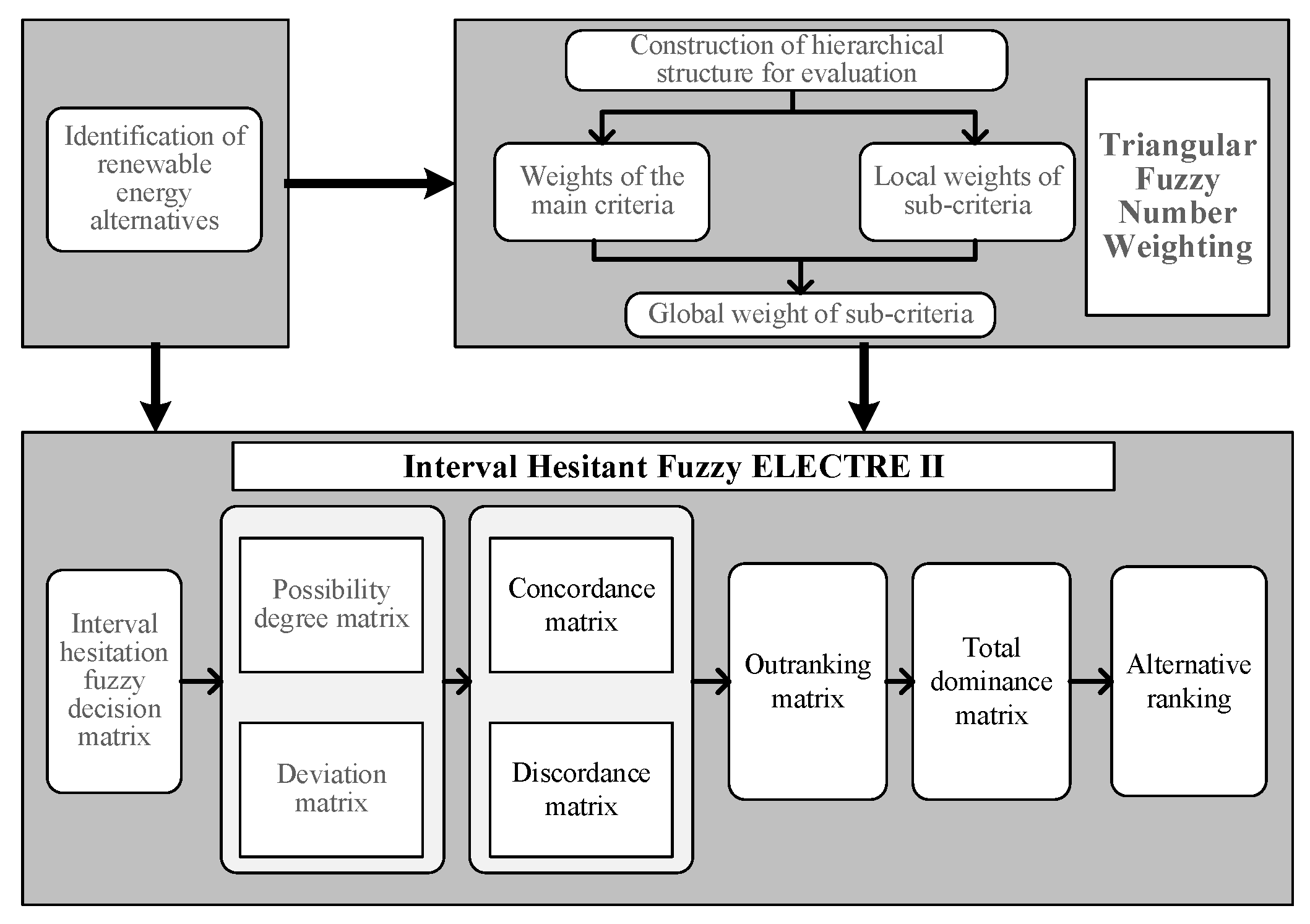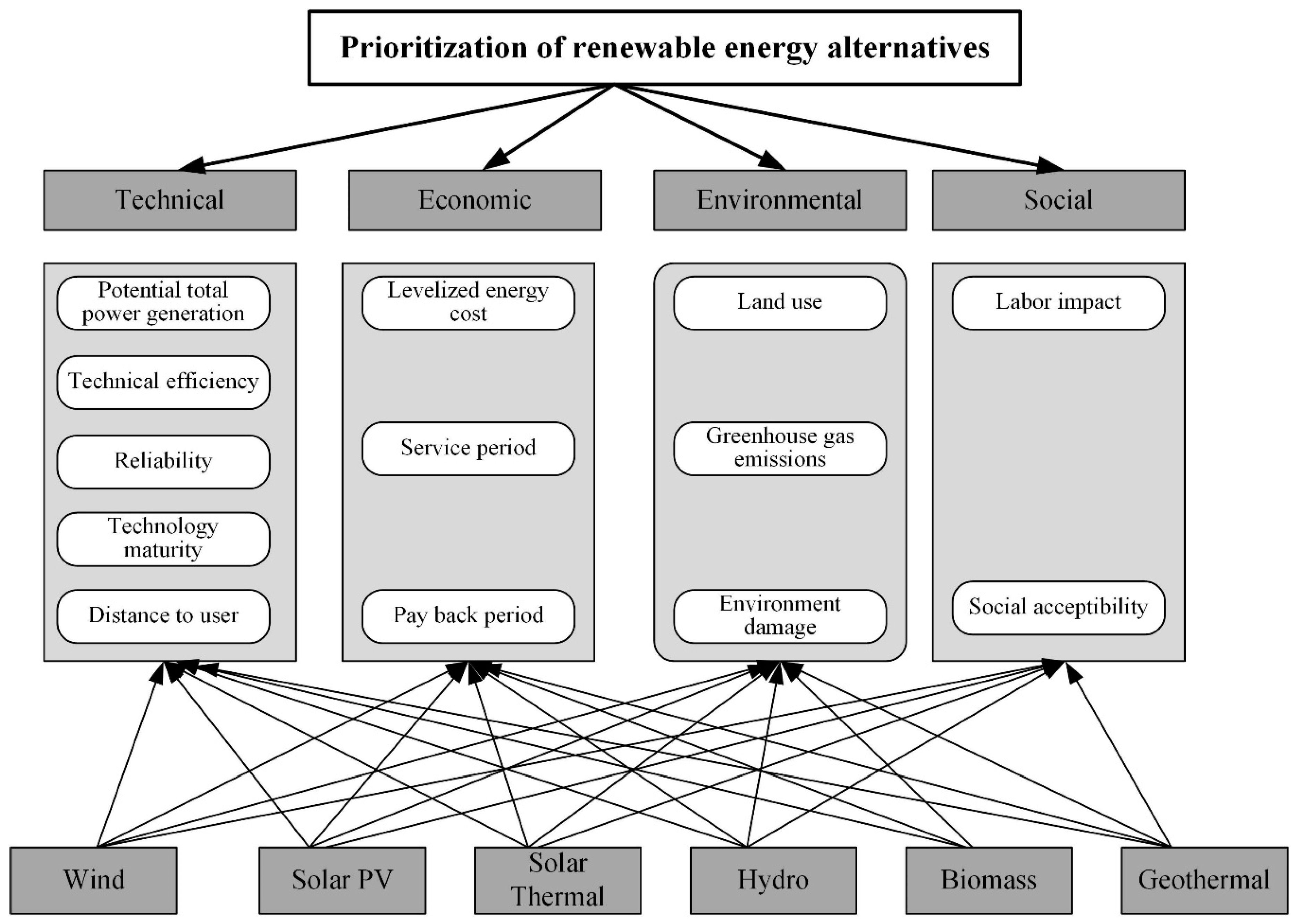Prioritization of Renewable Energy Alternatives for China by Using a Hybrid FMCDM Methodology with Uncertain Information
Abstract
1. Introduction
2. Methodology
2.1. Triangular Fuzzy Number Weighting
2.2. Interval-Valued Hesitant Fuzzy ELECTRE II
2.2.1. Preliminaries
2.2.2. Interval Hesitant Fuzzy ELECTRE II
- Hesitant fuzzy concordance and discordance indexes
- 2.
- Calculation of outranking matrix and total dominance matrix
2.3. Decision-Making Steps
3. Case Study and Results
3.1. Identification of Renewable Energy Alternatives
3.1.1. Wind
3.1.2. Solar
3.1.3. Hydro
3.1.4. Biomass
3.1.5. Geothermal
3.2. Triangular Fuzzy Number Weighting
3.2.1. Construction of Hierarchical Structure for Evaluation
3.2.2. Calculation of Triangular Fuzzy Number Weighting
3.3. Prioritization of Renewable Energy Alternatives in China
4. Discussion and Conclusions
Author Contributions
Funding
Conflicts of Interest
Appendix A
References
- BP p.l.c. BP Statistical Review of World Energy. Available online: http://www.bp.com/content/dam/bp/business-sites/en/global/corporate/pdfs/energy-economics/statistical-review/bp-stats-review-2019-full-report.pdf/ (accessed on 29 October 2019).
- Ming, Z.; Ximei, L.; Yulong, L.; Lilin, P. Review of renewable energy investment and financing in China: Status, mode, issues and countermeasures. Renew. Sustain. Energy Rev. 2014, 31, 23–37. [Google Scholar] [CrossRef]
- National Bureau of Statistics PRC Statistical yearbook of China; China Statistical Publishing House: Beijing, China, 2018.
- Strantzali, E.; Aravossis, K. Decision making in renewable energy investments: A review. Renew. Sustain. Energy Rev. 2016, 55, 885–898. [Google Scholar] [CrossRef]
- Kumar, A.; Sah, B.; Singh, A.R.; Deng, Y.; He, X.; Kumar, P.; Bansal, R.C. A review of multi criteria decision making (MCDM) towards sustainable renewable energy development. Renew. Sustain. Energy Rev. 2017, 69, 596–609. [Google Scholar] [CrossRef]
- Khan, M.I. Evaluating the strategies of compressed natural gas industry using an integrated SWOT and MCDM approach. J. Clean. Prod. 2018, 172, 1035–1052. [Google Scholar] [CrossRef]
- Kazancoglu, Y.; Ozturkoglu, Y. Integrated framework of disassembly line balancing with Green and business objectives using a mixed MCDM. J. Clean. Prod. 2018, 191, 179–191. [Google Scholar] [CrossRef]
- Florindo, T.J.; Florindo, G.D.M.; Talamini, E.; da Costa, J.S.; de Léis, C.M.; Tang, W.Z.; Schultz, G.; Kulay, L.; Pinto, A.T.; Ruviaro, C.F. Application of the multiple criteria decision-making (MCDM) approach in the identification of Carbon Footprint reduction actions in the Brazilian beef production chain. J. Clean. Prod. 2018, 196, 1379–1389. [Google Scholar] [CrossRef]
- Kaya, T.; Kahraman, C. Multicriteria renewable energy planning using an integrated fuzzy VIKOR & AHP methodology: The case of Istanbul. Energy 2010, 35, 2517–2527. [Google Scholar]
- Amer, M.; Daim, T.U. Selection of renewable energy technologies for a developing county: A case of Pakistan. Energy Sustain. Dev. 2011, 15, 420–435. [Google Scholar] [CrossRef]
- Çolak, M.; Kaya, İ. Prioritization of renewable energy alternatives by using an integrated fuzzy MCDM model: A real case application for Turkey. Renew. Sustain. Energy Rev. 2017, 80, 840–853. [Google Scholar] [CrossRef]
- Ahmad, S.; Nadeem, A.; Akhanova, G.; Houghton, T.; Muhammad-Sukki, F. Multi-criteria evaluation of renewable and nuclear resources for electricity generation in Kazakhstan. Energy 2017, 141, 1880–1891. [Google Scholar] [CrossRef]
- Tasri, A.; Susilawati, A. Selection among renewable energy alternatives based on a fuzzy analytic hierarchy process in Indonesia. Sustain. Energy Technol. Assess. 2014, 7, 34–44. [Google Scholar] [CrossRef]
- Nigim, K.; Munier, N.; Green, J. Pre-feasibility MCDM tools to aid communities in prioritizing local viable renewable energy sources. Renew. Energy 2004, 29, 1775–1791. [Google Scholar] [CrossRef]
- Chatzimouratidis, A.I.; Pilavachi, P.A. Technological, economic and sustainability evaluation of power plants using the Analytic Hierarchy Process. Energy Policy 2009, 37, 778–787. [Google Scholar] [CrossRef]
- Kahraman, C.; Ihsan, K.; Cebi, S. A comparative analysis for multiattribute selection among renewable energy alternatives using fuzzy axiomatic design and fuzzy analytic hierarchy process. Energy 2009, 34, 1603–1616. [Google Scholar] [CrossRef]
- Ahmad, S.; Tahar, R.M. Selection of renewable energy sources for sustainable development of electricity generation system using analytic hierarchy process: A case of Malaysia. Renew. Energy 2014, 63, 458–466. [Google Scholar] [CrossRef]
- Štreimikienė, D.; Šliogerienė, J.; Turskis, Z. Multi-criteria analysis of electricity generation technologies in Lithuania. Renew. Energy 2016, 85, 148–156. [Google Scholar] [CrossRef]
- Dvořák, P.; Martinát, S.; Van der Horst, D.; Frantál, B.; Turečková, K. Renewable energy investment and job creation; a cross-sectoral assessment for the Czech Republic with reference to EU benchmarks. Renew. Sustain. Energy Rev. 2017, 69, 360–368. [Google Scholar] [CrossRef]
- Şengül, Ü.; Eren, M.; Shiraz, S.E.; Gezder, V.; Şengül, A.B. Fuzzy TOPSIS method for ranking renewable energy supply systems in Turkey. Renew. Energy 2015, 75, 617–625. [Google Scholar] [CrossRef]
- Sadeghi, A.; Larimian, T.; Molabashi, A. Evaluation of renewable energy sources for generating electricity in province of Yazd: A fuzzy MCDM approach. Procedia-Soc. Behav. Sci. 2012, 62, 1095–1099. [Google Scholar] [CrossRef]
- Benayoun, R.; Roy, B.; Sussman, B. ELECTRE: Une méthode pour guider le choix en présence de points de vue multiples. Note Trav. 1966, 49. Available online: https://www.scirp.org/(S(351jmbntvnsjt1aadkposzje))/reference/ReferencesPapers.aspx?ReferenceID=2519107 (accessed on 29 October 2019).
- Govindan, K.; Jepsen, M.B. ELECTRE: A comprehensive literature review on methodologies and applications. Eur. J. Oper. Res. 2016, 250, 1–29. [Google Scholar] [CrossRef]
- Roy, B.; Bertier, P. La méthode ELECTRE II Note Trav. 142Dir.; Groupe Metra: Paris, France, 1971. [Google Scholar]
- Roy, B. ELECTRE III: Un algorithme de classements fondé sur une représentation floue des préférences en présence de critères multiples. Cah. CERO 1978, 20, 3–24. [Google Scholar]
- Roy, B.; Hugonnard, J.-C. Ranking of suburban line extension projects on the Paris metro system by a multicriteria method. Transp. Res. Part Gen. 1982, 16, 301–312. [Google Scholar] [CrossRef]
- Yu, W. ELECTRE TRI(aspects méthodologiques et manuel d’utilisation); Document du LAMSADEE; Université de Paris–Dauphine: Paris, France, 1992. [Google Scholar]
- Roy, B.; Bouyssou, D. Aide multicritère à la décision: Méthodes et Cas; Economica Paris: Paris, France, 1993; ISBN 2-7178-2473-1. [Google Scholar]
- Haralambopoulos, D.; Polatidis, H. Renewable energy projects: Structuring a multi-criteria group decision-making framework. Renew. Energy 2003, 28, 961–973. [Google Scholar] [CrossRef]
- Troldborg, M.; Heslop, S.; Hough, R.L. Assessing the sustainability of renewable energy technologies using multi-criteria analysis: Suitability of approach for national-scale assessments and associated uncertainties. Renew. Sustain. Energy Rev. 2014, 39, 1173–1184. [Google Scholar] [CrossRef]
- Neves, L.P.; Martins, A.G.; Antunes, C.H.; Dias, L.C. A multi-criteria decision approach to sorting actions for promoting energy efficiency. Energy Policy 2008, 36, 2351–2363. [Google Scholar] [CrossRef]
- Papadopoulos, A.; Karagiannidis, A. Application of the multi-criteria analysis method Electre III for the optimisation of decentralised energy systems. Omega 2008, 36, 766–776. [Google Scholar] [CrossRef]
- Catalina, T.; Virgone, J.; Blanco, E. Multi-source energy systems analysis using a multi-criteria decision aid methodology. Renew. Energy 2011, 36, 2245–2252. [Google Scholar] [CrossRef]
- Beccali, M.; Cellura, M.; Mistretta, M. Decision-making in energy planning. Application of the Electre method at regional level for the diffusion of renewable energy technology. Renew. Energy 2003, 28, 2063–2087. [Google Scholar]
- Polatidis, H.; Haralambidou, K.; Haralambopoulos, D. Multi-criteria decision analysis for geothermal energy: A comparison between the ELECTRE III and the PROMETHEE II methods. Energy Sources Part B Econ. Plan. Policy 2015, 10, 241–249. [Google Scholar] [CrossRef]
- Sánchez-Lozano, J.M.; Antunes, C.H.; García-Cascales, M.S.; Dias, L.C. GIS-based photovoltaic solar farms site selection using ELECTRE-TRI: Evaluating the case for Torre Pacheco, Murcia, Southeast of Spain. Renew. Energy 2014, 66, 478–494. [Google Scholar] [CrossRef]
- Jun, D.; Tian-tian, F.; Yi-sheng, Y.; Yu, M. Macro-site selection of wind/solar hybrid power station based on ELECTRE-II. Renew. Sustain. Energy Rev. 2014, 35, 194–204. [Google Scholar] [CrossRef]
- Sánchez-Lozano, J.; García-Cascales, M.; Lamata, M. Comparative TOPSIS-ELECTRE TRI methods for optimal sites for photovoltaic solar farms. Case study in Spain. J. Clean. Prod. 2016, 127, 387–398. [Google Scholar] [CrossRef]
- Mousavi, M.; Gitinavard, H.; Mousavi, S. A soft computing based-modified ELECTRE model for renewable energy policy selection with unknown information. Renew. Sustain. Energy Rev. 2017, 68, 774–787. [Google Scholar] [CrossRef]
- Wu, Y.; Zhang, J.; Yuan, J.; Geng, S.; Zhang, H. Study of decision framework of offshore wind power station site selection based on ELECTRE-III under intuitionistic fuzzy environment: A case of China. Energy Convers. Manag. 2016, 113, 66–81. [Google Scholar] [CrossRef]
- Zhang, L.; Xu, X.; Tao, L. Some similarity measures for triangular fuzzy number and their applications in multiple criteria group decision-making. J. Appl. Math. 2013, 2013, 1–7. [Google Scholar] [CrossRef]
- Liang, X.; Guo, T.; Meng, X. A method on macroscopic traffic safety evaluation based on weighting triangular fuzzy number algorithm. J. Transp. Inf. Saf. 2017, 35, 20–28. [Google Scholar]
- Chen, N.; Xu, Z.; Xia, M. Interval-valued hesitant preference relations and their applications to group decision making. Knowl.-Based Syst. 2013, 37, 528–540. [Google Scholar] [CrossRef]
- Szmidt, E.; Kacprzyk, J. Distances between intuitionistic fuzzy sets. Fuzzy Sets Syst. 2000, 114, 505–518. [Google Scholar] [CrossRef]
- McElroy, M.B.; Lu, X.; Nielsen, C.P.; Wang, Y. Potential for wind-generated electricity in China. Science 2009, 325, 1378–1380. [Google Scholar] [CrossRef]
- Nazir, M.S.; Mahdi, A.J.; Bilal, M.; Sohail, H.M.; Ali, N.; Iqbal, H.M. Iqbal Environmental impact and pollution-related challenges of renewable wind energy paradigm—A review. Sci. Total Environ. 2019, 683, 436–444. [Google Scholar] [CrossRef]
- China Renewable Energy Development Report; National Development and Reform Commission (NDRC): Beijing, China, 2006.
- Li, K.; Fan, H.N. Regional analysis of China’s terrestrial solar resource development potential. Prog. Geogr. 2010, 9, 27–32. [Google Scholar]
- Zhou, D. The Overview of Geothermal Power Generation. Electr. Power Surv. 2003, 3, 1–6. [Google Scholar]
- Grid-Connected Operation of Photovoltaic Power Generation in 2019; National Energy Administration: Beijing, China, 2020.
- Solar energy and the environment-U.S. Energy Information Administration (EIA). Available online: https://www.eia.gov/energyexplained/solar/solar-energy-and-the-environment.php (accessed on 2 June 2020).
- Zhang, D.; Wang, J.; Lin, Y.; Si, Y.; Huang, C.; Yang, J.; Huang, B.; Li, W. Present situation and future prospect of renewable energy in China. Renew. Sustain. Energy Rev. 2017, 76, 865–871. [Google Scholar] [CrossRef]
- Huang, H.; Yan, Z. Present situation and future prospect of hydropower in China. Renew. Sustain. Energy Rev. 2009, 13, 1652–1656. [Google Scholar] [CrossRef]
- Chang, X.; Liu, X.; Zhou, W. Hydropower in China at present and its further development. Energy 2010, 35, 4400–4406. [Google Scholar] [CrossRef]
- Hydropower and the environment-U.S. Energy Information Administration (EIA). Available online: https://www.eia.gov/energyexplained/hydropower/hydropower-and-the-environment.php (accessed on 2 June 2020).
- National Energy Administration. The 12th five-year plan for biomass energy development. Available online: http://zfxxgk.nea.gov.cn/auto87/201212/t20121228_1568.htm/ (accessed on 2 June 2020).
- Jiaxin He; Runqing Zhu; Boqiang Lin Prospects, obstacles and solutions of biomass power industry in China. J. Clean. Prod. 2019, 237, 117783. [CrossRef]
- Saxena, R.C.; Adhikari, D.K.; Goyal, H.B. Biomass-based Energy Fuel Through Biochemical Routes: A Review. Renew. Sustain. Energy Rev. 2009, 13, 156–167. [Google Scholar] [CrossRef]
- Vamvuka, D.; Kakaras, E. Ash properties and environmental impact of various biomass and coal fuels and their blends. Fuel Process. Technol. 2011, 92, 570–581. [Google Scholar] [CrossRef]
- Ling-zhen, K. Development Trend of Geothermal Energy Resource in China. Coal Technol. 2006, 7, 067. [Google Scholar]
- Liu, W.; Lund, H.; Mathiesen, B.V.; Zhang, X. Potential of renewable energy systems in China. Appl. Energy 2011, 88, 518–525. [Google Scholar] [CrossRef]
- Ármannsson, H.; Kristmannsdóttir, H. Geothermal environmental impact. Geothermics 1992, 21, 869–880. [Google Scholar] [CrossRef]
- Kabak, M.; Dağdeviren, M. Prioritization of renewable energy sources for Turkey by using a hybrid MCDM methodology. Energy Convers. Manag. 2014, 79, 25–33. [Google Scholar] [CrossRef]
- Chen, H. Optimizing Sichuan Clean Energy Delivery by Hydro/Wind Power Complementation. Electr. Power 2017, 50, 37–43. [Google Scholar] [CrossRef]
- Liu, Y.; Sun, C.; Xia, B.; Cui, C.; Coffey, V. Impact of community engagement on public acceptance towards waste-to-energy incineration projects: Empirical evidence from China. Waste Manag. 2018, 76, 431–442. [Google Scholar] [CrossRef] [PubMed]
- Y, Q. Studies on the Mid—term Evaluation of the Hydropower Development in China during the 13thFive—Year Plan; Chinese Academy of Sciences, Institute of Resources and Environmental Policy: Beijing, China, 2018. [Google Scholar]
- Dong, S. Evaluation Center of the State Council. China Geothermal Energy Development Report (2018); China Geological Survey, Ministry of Natural Resources, Department of New Energy and Renewable Resources; National Energy Administration, Institute of Science and Technology Strategy Consulting; Chinese Academy of Sciences, Institute of Resources and Environmental Policy: Beijing, China, 2018. [Google Scholar]
- Al Garni, H.; Kassem, A.; Awasthi, A.; Komljenovic, D.; Al-Haddad, K. A multicriteria decision making approach for evaluating renewable power generation sources in Saudi Arabia. Sustain. Energy Technol. Assess. 2016, 16, 137–150. [Google Scholar] [CrossRef]
- Stein, E.W. A comprehensive multi-criteria model to rank electric energy production technologies. Renew. Sustain. Energy Rev. 2013, 22, 640–654. [Google Scholar] [CrossRef]
- Wu, C.; Zhou, Z.; Ma, L.; Yin, X. Comparative study on biomass power generation technologies. Kezaisheng NengyuanRenewable Energy Resour. 2008, 26, 34–37. [Google Scholar]
- Dong, S. Evaluation of Investment Economic Benefit of XY Thermal Power Plant 2 × 350MW Construction Project. Master’s Thesis, Jilin University, Changchun, China, 2015. [Google Scholar]
- Coskun, A.; Bolatturk, A.; Kanoglu, M. Thermodynamic and economic analysis and optimization of power cycles for a medium temperature geothermal resource. Energy Convers. Manag. 2014, 78, 39–49. [Google Scholar] [CrossRef]
- Reddy, V.S.; Kaushik, S.; Tyagi, S. Exergetic analysis and performance evaluation of parabolic trough concentrating solar thermal power plant (PTCSTPP). Energy 2012, 39, 258–273. [Google Scholar] [CrossRef]
- Amponsah, N.Y.; Troldborg, M.; Kington, B.; Aalders, I.; Hough, R.L. Greenhouse gas emissions from renewable energy sources: A review of lifecycle considerations. Renew. Sustain. Energy Rev. 2014, 39, 461–475. [Google Scholar] [CrossRef]








| Main Criteria | Subcriteria | Unit | Criteria Type | The Principal of Evaluation | Related Reference | |
|---|---|---|---|---|---|---|
| Prioritization of Renewable energy alternatives | Technical A | Potential total power generation A1 | TWh/y | Maximize | The potential amount of the renewable generation per year. | [13] |
| Technical efficiency A2 | % | Maximize | The ratio of output electrical energy to input energy specifically. | [11,18,20,62] | ||
| Reliability A3 | - | Maximize | The continuity of electricity supply and the predictability of the specific renewable power generation technology. | [13,20,63] | ||
| Technology Maturity A4 | - | Maximize | State-of-the-art of technology. | [13,18,20,63] | ||
| Distance to User A5 | - | Minimize | Distance between renewable energy and users. | [16,64] | ||
| Economic B | Levelized energy cost B1 | Pound / MWh | Minimize | All the costs over the renewable energy system’s lifespan. | [13,63] | |
| Service period B2 | Year | Maximize | The average useful life of renewable energy power generation. | [63,65] | ||
| Payback period B3 | Year | Minimize | The time that is necessary to reach the break-even point and compensate the original cost of renewable energy investment. | [63,65] | ||
| Environmental C | Land use C1 | M2/kw | Minimize | The average land area required for the renewable technology. | [13,18,63,64,66] | |
| Greenhouse gas emissions C2 | gCO2eq/kWh | Minimize | The life-cycle greenhouse gas emissions from the renewable technology. | [13,18,63] | ||
| Environment damage C3 | - | Minimize | The impairment of renewable energy generation to the environment. | [10,18,63] | ||
| Social D | Labor impact D1 | Jobs/MW | Maximize | Number of jobs provided or driven by renewable technology. | [18,29,63,64,66] | |
| Social acceptability D2 | - | Maximize | Civil acceptance or attitude towards renewable energy projects. | [13,18,20,29,63,64,66] |
| A | B | C | D | |
| A | ||||
| B | ||||
| C | ||||
| D |
| A1 | A2 | A3 | A4 | A5 | |
| A1 | |||||
| A2 | |||||
| A3 | |||||
| A4 | |||||
| A5 |
| B1 | B2 | B3 | |
| B1 | |||
| B2 | |||
| B3 |
| C1 | C2 | C3 | |
| C1 | |||
| C2 | |||
| C3 |
| D1 | D2 | |
| D1 | ||
| D2 |
| A | B | C | D | |
| A | 1 | 1 | 1 | 1 |
| B | 0.6606 | 1 | 1 | 1 |
| C | 0.5120 | 2.2482 | 1 | 1 |
| D | 0.1763 | 0.4619 | 0.6072 | 1 |
| Main Criteria | Weights | Subcriteria | Local Weights | Global Weights |
|---|---|---|---|---|
| Technical(A) | 0.4257 | Potential total power generation(A1) | 0.1987 | 0.0846 |
| Technical efficiency(A2) | 0.1486 | 0.0633 | ||
| Reliability(A3) | 0.2424 | 0.1032 | ||
| Technology Maturity(A4) | 0.2760 | 0.1175 | ||
| Distance to User(A5) | 0.1342 | 0.0572 | ||
| Economic(B) | 0.2812 | Levelized energy cost(B1) | 0.6307 | 0.1774 |
| Service period(B2) | 0.1084 | 0.0305 | ||
| Payback period(B3) | 0.2610 | 0.0734 | ||
| Environmental (C) | 0.2180 | Land use(C1) | 0.2637 | 0.0575 |
| Greenhouse gas emissions(C2) | 0.3682 | 0.0802 | ||
| Environment damage(C3) | 0.3682 | 0.0802 | ||
| Social(D) | 0.0750 | Labor impact(D1) | 0.6656 | 0.0499 |
| Social acceptability(D2) | 0.3344 | 0.0251 |
| Subcriteria | Unit | Wind | Solar PV | Solar Thermal | Hydro | Biomass | Geothermal | Reference |
|---|---|---|---|---|---|---|---|---|
| Potential total power generation(A1) | TWh/y | - 247,000 | 1296– 6480 | 575–2876 | 2474 –6083 | 1532–2696 | 7.12 | [61,67] |
| Technical efficiency(A2) | % | 35 | 9.5–12 | 21 | 80 | 14–35 | 11.4 | [68,69,70] |
| Reliability(A3) | - | (0.5,0.7) (0.6,0.7) (0.5,0.8) | (0.6,0.8) (0.7,0.8) (0.6,0.7) | (0.2,0.4) (0.3,0.4) (0.4,0.5) | (0.8,1) (0.9,0.1) (0.8,0.9) | (0.6,0,8) (0.7,0.9) (0.5,0.7) | (0.5,0.8) (0.6,0.7) (0.4,0.5) | EA |
| Technology Maturity(A4) | - | (0.7,0.8) (0.7,0.8) (0.8,0.9) | (0.6,0.8) (0.7,0.9) (0.7,0.9) | (0.2,0.4) (0.3,0.4) (0.5,0.6) | (0.8,1) (0.8,0.9) (0.9,1) | (0.4,0.7) (0.6,0.7) (0.5,0.6) | (0.2,0.4) (0.3,0.5) (0.3,0.4) | EA |
| Distance to User(A5) | - | (0.6,0.7) (0.7,0.8) (0.8,0.9) | (0.7,0.8) (0.7,0.9) (0.8,1) | (0.2,0.3) (0.2,0.4) (0.3,0.4) | (0.6,0.8) (0.7,0.8) (0.7,0.8) | (0.7,0.9) (0.6,0.8) (0.7,0.8) | (0.2,0.4) (0.3,0.4) (0.2,0.3) | EA |
| Levelized energy cost(B1) | Yuan/ MWh | Onshore: 44–211; Offshore: 70–1091 | 79–2639 | 264–1320 | 18–660 | Dedicated biomass: 123–5719; Energy from waste: 853–8798 | 97–686 | [30] |
| Service period(B2) | Year | 20–30 | 20–30 | 10–30 | 40–100 | 25–45 | 20–60 | [71,72] |
| Payback period(B3) | Year | 13–16 | 7–13 | 8–12 | 5–10 | 6–9.5 | 4–9 | [22] |
| Land use(C1) | m2/kW | 10–1200 | 10–500 | 10–100 | 10–6500 | 1000–6000 | 20–1000 | [14,73] |
| Greenhouse gas emissions(C2) | gCO2eq/kWh | Onshore: 5–24; Offshore: 8–124 | 9–300 | 30–150 | 2–75 | Dedicated biomass: 14–650; Energy from waste: 97–1000 | 11–78 | [74] |
| Environment damage(C3) | - | (0.7,0.9) (0.6,0.7) (0.6,0.8) | (0.6,0.7) (0.7,0.9) (0.8,0.9) | (0.6,0.8) (0.5,0.6) (0.6,0.7) | (0.3,0.6) (0.4,0.5) (0.3,0.5) | (0.5,0.6) (0.5,0.7) (0.6,0.7) | (0.4,0.8) (0.2,0.6) (0.4,0.5) | EA |
| Labor impact(D1) | Jobs/MW | 0.9–4.0 | 0.7–25 | 0.2–5.0 | 0.9–1.2 | 11.2–19.8 | 0.25–2.5 | [19] |
| Social acceptability(D2) | - | (0.7,0.8) (0.8,0.9) (0.8,0.9) | (0.6,0.7) (0.7,0.9) (0.8,0.9) | (0.6,0.7) (0.7,0.9) (0.5,0.7) | (0.6,0.8) (0.7,0.8) (0.6,0.9) | (0.4,0.6) (0.7,0.8) (0.6,0.9) | (0.4,0.6) (0.5,0.7) (0.3,0.5) | EA |
| Subcriteria | Wind | Solar PV | Solar Thermal Power | Hydro | Biomass | Geothermal |
|---|---|---|---|---|---|---|
| Potential total power generation(A1) | (0.03,1) | (0.01,0.03) | (0,0.01) | (0.01,0.02) | (0.01,0.01) | (0.000029, 0.000029) |
| Technical efficiency(A2) | (0.44,0.44) | (0.12,0.15) | (0.26,0.26) | (1.0,1.0) | (0.18,0.44) | (0.14,0.14) |
| Reliability(A3) | (0.5,0.7) (0.6,0.7) (0.5,0.8) | (0.6,0.8) (0.7,0.8) (0.6,0.7) | (0.2,0.4) (0.3,0.4) (0.4,0.5) | (0.8,1) (0.9,0.1) (0.8,0.9) | (0.6,0,8) (0.7,0.9) (0.5,0.7) | (0.5,0.8) (0.6,0.7) (0.4,0.5) |
| Technology Maturity(A4) | (0.7,0.8) (0.7,0.8) (0.8,0.9) | (0.6,0.8) (0.7,0.9) (0.7,0.9) | (0.2,0.4) (0.3,0.4) (0.5,0.6) | (0.8,1) (0.8,0.9) (0.9,1) | (0.4,0.7) (0.6,0.7) (0.5,0.6) | (0.2,0.4) (0.3,0.5) (0.3,0.4) |
| Distance to User(A5) | (0.6,0.7) (0.7,0.8) (0.8,0.9) | (0.7,0.8) (0.7,0.9) (0.8,1) | (0.2,0.3) (0.2,0.4) (0.3,0.4) | (0.6,0.8) (0.7,0.8) (0.7,0.8) | (0.7,0.9) (0.6,0.8) (0.7,0.8) | (0.2,0.4) (0.3,0.4) (0.2,0.3) |
| Levelized energy cost(B1) | (0.05,0.2) (0.08,0.4) | (0.02,0.2) | (0.02,0.2) | (0.08,1) | (0.04,0.2) (0.06,0.25) | (0.05,1) |
| Service period(B2) | (0.2,0.3) | (0.2,0.3) | (0.1,0.3) | (0.4,1) | (0.25,0.45) | (0.2,0.6) |
| Payback period(B3) | (0.25,0.31) | (0.31,0.57) | (0.33,0.5) | (0.4,0.8) | (0.42,0.67) | (0.44,1) |
| Land use(C1) | (0.01,1) | (0.02,1) | (0.1,1) | (0,1) | (0.002,0.01) | (0.01,0.5) |
| Greenhouse gas emissions(C2) | (0.08,0.4) (0.02,0.25) | (0.01,0.22) | (0.01,0.07) | (0.03,1) | (0, 0.14) (0, 0.02) | (0.03,0.18) |
| Environment damage(C3) | (0.7,0.9) (0.6,0.7) (0.6,0.8) | (0.6,0.7) (0.7,0.9) (0.8,0.9) | (0.6,0.8) (0.5,0.6) (0.6,0.7) | (0.3,0.6) (0.4,0.5) (0.3,0.5) | (0.5,0.6) (0.5,0.7) (0.6,0.7) | (0.4,0.8) (0.2,0.6) (0.4,0.5) |
| Labor impact(D1) | (0.04,0.16) | (0.03,1) | (0.01,0.2) | (0.04,0.05) | (0.45,0.79) | (0.01,0.1) |
| Social acceptability(D2) | (0.7,0.8) (0.8,0.9) (0.8,0.9) | (0.6,0.7) (0.7,0.9) (0.8,0.9) | (0.6,0.7) (0.7,0.9) (0.5,0.7) | (0.6,0.8) (0.7,0.8) (0.6,0.9) | (0.4,0.6) (0.7,0.8) (0.6,0.9) | (0.4,0.6) (0.5,0.7) (0.3,0.5) |
© 2020 by the authors. Licensee MDPI, Basel, Switzerland. This article is an open access article distributed under the terms and conditions of the Creative Commons Attribution (CC BY) license (http://creativecommons.org/licenses/by/4.0/).
Share and Cite
Niu, D.; Zhen, H.; Yu, M.; Wang, K.; Sun, L.; Xu, X. Prioritization of Renewable Energy Alternatives for China by Using a Hybrid FMCDM Methodology with Uncertain Information. Sustainability 2020, 12, 4649. https://doi.org/10.3390/su12114649
Niu D, Zhen H, Yu M, Wang K, Sun L, Xu X. Prioritization of Renewable Energy Alternatives for China by Using a Hybrid FMCDM Methodology with Uncertain Information. Sustainability. 2020; 12(11):4649. https://doi.org/10.3390/su12114649
Chicago/Turabian StyleNiu, Dongxiao, Hao Zhen, Min Yu, Keke Wang, Lijie Sun, and Xiaomin Xu. 2020. "Prioritization of Renewable Energy Alternatives for China by Using a Hybrid FMCDM Methodology with Uncertain Information" Sustainability 12, no. 11: 4649. https://doi.org/10.3390/su12114649
APA StyleNiu, D., Zhen, H., Yu, M., Wang, K., Sun, L., & Xu, X. (2020). Prioritization of Renewable Energy Alternatives for China by Using a Hybrid FMCDM Methodology with Uncertain Information. Sustainability, 12(11), 4649. https://doi.org/10.3390/su12114649






